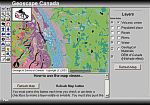Proactive disclosure
Print version   |  | 
Natural Resources Canada > Earth Sciences Sector > Geological Survey of Canada > Climate Change
Climate Change Canadian Peatland Database
The Canadian Peatland Database contains information on the nature and distribution of peatland in Canada. There is an estimated 154 GT of carbon in Canadian peatlands, 95% of which is found in boreal, subarctic, and arctic areas (Tarnocai, 1998). Sixty percent of the area of Canadian peatlands is expected to be severly to extremely severly affected by climate warming caused by a doubling of CO2 (Kettles and Tarnocai, 2000). In areas of discontinuous permafrost, permafrost distribution is closely tied to the distribution of peatlands. Thaw subsidence resulting from degradation of segregated ice in bogs and the compressibility of thawed peat presents serious problems for construction and maintenance of highways, pipelines, buildings and other infrastructure in areas of extensive organic terrain. Poor drainage in fens and the high compressibility and low strength of fen peat, make them unsuitable for any development. With climate warming, release of greenhouse gases from peatlands will be influenced by the degradation of permafrost, particularly in areas which are discontinuously frozen. At present the production of greenhouse gas is extremely limited within the extensive areas of permafrost-bearing peatlands. Within unfrozen fens, degrading peat may produce greater than 100 times more methane, a major greenhouse gas, than peat in nearby frozen areas, per unit area (Watson et al., 1990). The Canadian Peatland Database will serve as baseline data for monitoring the effects of climate change on peatland and its impact on the Canadian environment.

Launch the viewer
|

